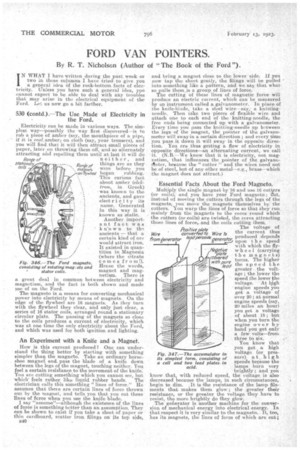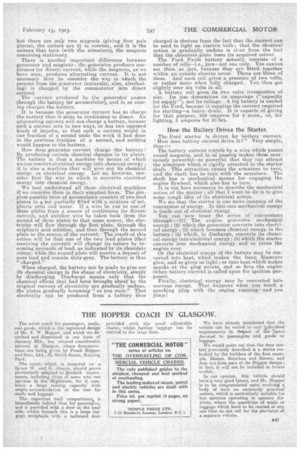FORD VAN POINTERS.
Page 26

Page 27

If you've noticed an error in this article please click here to report it so we can fix it.
By R. T. Nicholson (Author of "The Book of the Ford ").
IN WHAT I have written during the past week or two in these columns I have tried to give you a general idea of the rock-bottom_ facts of electricity. Unless you have such a general idea, ynti
• cannot expect to be able to deal with any troubles that may arise in the electrical equipment of the Ford. Let us now go a bit farther.
530 (contd.).--The Use Made of Electricity in . the Ford.
Electricity can he made in various ways. The simplest way—possibly the way first discovered—is to rub a piece of amber (say, the,. mouthpieceof a pipe,
'-if it is real/amber) on cloth (say, your trousers), and you will find that it will then attract small pieces of paper, later .On throwing them off, and so alternately attracting and repelling them until at last it will do Range of neither, and staiionary . . ... , . Rom; e .07, things are as they coifs . ... were before you .czahykvbeel began rubbing. This curious fact about amber (risktram, in Greek) was known to the ancients, and gave electricity its name. Generated in this way it is known as static.
Another important fact was k ri.`n w n to the ancients — that a certain kind of ore would attract iron. It existed in quantities in Magnesia (where the citrate comes froml). Hence the words, magnet and magnetism. There is a great deal in common between electricity and magnetism, and the fact is both shown and made use of on the Ford.
The magneto is a means for converting mechanical power into electricity by means of magnets. On the edge of the flywheel are 16 magnets. As they turn with the flywheel they clear, and only just clear, a series of 16 stator coils, arranged round a stationary circular plate. The passing of the magnets so close to the coils produces a current of electricity, which was at one time the only electricity about the Ford, and which was used for both ignition and lighting.
An Experiment with a Knife and a Magnet.
How is this current produced ? One can understand the thing better by starting with something simpler than the magneto. Take an ordinary horseshoe magnet and, pass the blade of a knife down between the legs of the magnet, touching neither. You feel a certain resislance to the movement of the knife. You are cutting something which you cannot see, hut which' feels rather like liquid rubber bands. The electrician calls this something "lines of force." He assumes that there are certain lines of force thrown out by the magnet, and tells you that you cut these lines of force when you use the knife blade. I say "assume"—althaugh the existence, of the lines of force is something better than an assumption. They can be shown to exist if you take a sheet of paper or thin cardboard, scatter iron filings on its top side,
B40
and bring a magnet close to the lower side. If you now tap the sheet gently, the filings will be pulled into something like a pattern, and we say, that what so puflo thern.ia a group of lines of force.
The cutting of these lines of Magnetic force will produce an electric current, which can be measured by an instrument called a galvanometer. In place of. the knife-blade, take a steel wire—say,a knitting
needle. Then take two -pieces of flexible wire and attach one to each end of the knitting-needle, the free ends being connected up with a galvanometer. Every time you pass the knitting-needle up between. the legs of the magnet, the painter of the galvanometer will Sway in a certain direction ; and every time you pass.it down it will sway in the opposite direction. You are thusgetting a_ flow of electricity in Opposite directions—an alternating current, we call it. (N.B.—We know that it is electricity, not magnetism, that influencesthe painter of the galvanoMeter, beleause the " cutter " and the wires need' not be of steel, but of any alher metal—e.g., brass—which the magnet does not attract.)
Essential Facts About the Ford Magneto.
Multiply the single magnet by 16 and use 16 euttprs (or coils); and you have your Ford magneto.; instead of moving the cutters through the legS of the magnets; you move the magnets therriSelves by the cutters. You warp the lines of farce so that they 11111_ mainly from the magnets to the cores round which the cutters (or coils) are twisted, the, cores attracting those lines of farce, and the coils cutting them. • Wire • RisitIke plate th eanverNd fa Wire to the current, us filaniganernttor leadPeraride gfeneratar produced depends
upon t h e speed upon t h e speed
with which the flywheel (carrying the magnets) turns. The higher the speed the greater • the voltage • the lower the speed the lower the voltage. 'At high engine speeds you get a voltage of over 20; at normal engine speeds (say, 20 miles an hour) you get a voltage of about 18; but when you turn the engine over by hand you get only a few volts—from three to six. - You know that you get. a high voltage (or pres• sure) at high spebds because the lamps burn very brightly ; and you know that, with reduced speed, the voltage is also decreased 'because the lamps, in such circumstances, begin to dim. It is the resistance of the lamp filaments that makes them glow ; the greater their resistance, or the greater the voltage they have to resist, the more brightly do they glow.
The gefierator is another machine for the conversion of mechanical energy into electrical energy. In that respect it is very similar to the magneto. It, too, has its magnets, the lines of force of which are cut ;
347.—The accumulator in its simplest form, consisting of a cell and two lead plates in acid.
but there are orify two magnets (giving four pole pieces), the cutters are 21 in number, and it is the cutters that turn with the armature), the magnets remaining stationary.
• There is another important difference between generator and magneto ; the generator produces continuous (or direct) current, while the magneto, as we have seen, produces alternating current. it is not necessary here to consider the way in wiii,ch the current from the generator (naturally, also, alteinating) is changed by the commutator into direct current.
The current produced by the generator passes through the battery (or accumulator), and in so Passing charges the battery.
It is because the generator current has to charge the battery that it must, be continuous or divect. An alternating current will not charge a battery, because such a current acts in two ways, or has two opposed kinds of impulse, so that such a current would in one -fraction of a second undo the work it had done in the previous fraction of a second, and nothing would happen to the battery.
Haw does generator currept Charge the battery By producing certain chemical changes in its Plates.The battery is thus a machine by means of which we can convert electrical energy into chemical energy ; it is also a, machine that will give out it chemical energy as electrical energy: Let us, however, consider first the way in which it converts electrical energy into chemical energy.
We bestunderstand all these electrical machines if we consider them in their simplest form. The sinspleat possible form of accumulator consiets of two lead plates in a i'sr partially filled with a mixture of sulphuric am.ii and water. If a wire be run to one of these plates from a source of continuous (or direct) current, and another wire be taken back from the second of these plates to that same source, the electricity will flow through the first plate, through the sulphuric acid solution, and then through the second plate to the source of the current. The result of this action will be that one of the two lead plates (that receiving the current) will change its nature by becoming peroxide of lead, as indicated by its chocolate. colour, while the second plate will receive a. deposit of pure lead and remain Slaty-grey. The 'battery is thus " charged."
When charged, the battery can be made to give out. its chemical. energy in the shape of electricity, simply by discharging. Discharge means only that the chemical effects that had been brought about" by the original current of electricity are gradually undone, the plates gradually becoming "as you were." That electricity can be produced from a battery thus
charged is obvious from the fact that the current can be used to light an electric bulb -; that the chemical action is gradually undone is char from the fact that the chocolate plate loses its acquired colour. The • Ford Exide battery actually consists of a number of cells—i.e., jars—not one only. You cannot see them as jars, because they are fitted together within an outside ebonite cover. There are three of them. And each cell gives a pressure of two volts, or rather more when fully charged. You thus get slightly over six volts in all.
A battery cell gives its two volts irrespective of size. Its size determines its amperage (" capacity for supply "), not its voltage. A big battery is needed for the Ford, because it supplies the current required for starting—a heavy drain. It is capable of giving for that parprise, 235 amperes for 5 muss., or, for lighting, 3 amperes for 30 hrs.
How the BaZtery-Drives the Starter.
The Ford starter is driven by battery current. 'How does battery current drive it? " Very simply, thus:—
The battery current travels by a wire which passes round magnets, and in sopassing makes them enormously powerful—so powerful that they can attract the armature which is rigidly attached to the starter shalt, This attraction causes the armature to turn, and the shaft has to turn with the armature. The shaft has a mechanical means for . engaging the engine flywheel, which also has tcsturn.
It is not here necessary to describe the mechanical action of the starter ; all that I want to do is to give some rough idea of its electrical action. We see that the starter is one more instance of the conversion of energy. In this case mechanical energy is made out of electrical energy. You can now trace • the series of conversions through :—(1) The engine generates mechanical energy ; (2) which the generator converts into electrical energy ; (3) which becomes chemical energy in the battery ; (4) which, in discharge, converts its chemical energy into electrical energy.; (5) which the starter converts into mechanical energy and so turns the engine over. Or the electrical-energy of the battery may be converted into heat, which makes the lamp filaments glow, and so gives us light ; or into heat which mattes sparks at the plug points, and so firesthe engine (when battery current is called upon for ignition purposes). Finally, electrical energy may be converted info nervous energy. That happens when you touch a sparking plug with the engine running—and you jump !
































